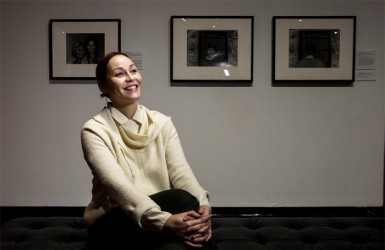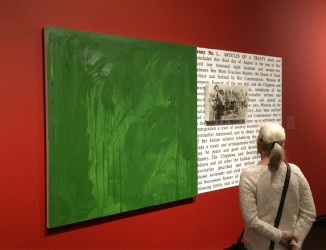Article Origin
Volume
33
Issue
12
Year
2016
The Winnipeg Art Gallery’s new curatorial resident of Indigenous and Contemporary Art has found a unique way to draw attention to the discussion around treaty territories and land claims.Jaimie Isaac of the Sagkeeng First Nation is the curator of an exhibit called “We are on Treaty Land” opening Feb. 5 with a public celebration beginning at 6:30 p.m.The exhibit pays homage specifically to Treaty 1, the treaty that encompasses the city of Winnipeg and surrounding area. It acknowledges and honours that Winnipeg is situated geographically on the traditional territory of Treaty No.1 and homeland of the Métis.
Photo: Jaimie Isaac is curatorial resident of Indigenous and Contemporary Art at the Winnipeg Art Gallery
Art: Premises for Self Rule: Treaty No. 1, 1994 acrylic, photo emulsion, vinyl lettering on canvas, Plexiglas 152 x 304 x 5 cm Collection of the Winnipeg Art Gallery, G-96-11 abc Photo provided by the Winnipeg Art Gallery.
“We’re talking about treaties, agreements, and the history, and how it affected our past and present and future ways of relations,” Isaac told Windspeaker.Isaac has collected pieces from the gallery’s permanent exhibit that highlight treaty and land claims in order to open up discussion about the government’s and public’s responsibilities today.
“It ranges from paintings to mixed media to photography… And I selected a couple of pieces from the Manitoba Museum. I picked them as active witnesses of Indigenous Agency within the Treaty 1 agreement,” said Isaac.Isaac, whose two-year residency began last September, often works with themes pulled from Indigenous issues, but this particular topic gave her the opportunity to research an area she wasn’t entirely familiar with. And it gave her added insight into what is, and what is not, being honored in treaty by the government today.“Coming from the traditional education system, I didn’t learn about treaties, and the Indian residential school system, and the colonial realities that still exist today. And it’s not just an Indigenous problem,” said Isaac.“Indigenous and non-Indigenous people need to learn to work together to learn about those things… that’s what I learned while researching,” she said.The items Isaac borrowed from the Manitoba Museum include a beaded bandelier bag from the 1890s, a set of moccasins from the same era, a birchbark basket, and a choker necklace. The use of these items in her exhibit allows her to highlight her feeling about colonial policies—which came hand-in-hand with the signing of treaties.“It was a colonial practice with institutions to name these beautiful objects from Indigenous cultures an artifact…To underscore their nature of being a beautiful art aesthetic that someone put a lot of talent and time into… I’m changing the labels on them from artifact to art,” she said.Isaac has also chosen works from Robert Houle, Jeffrey Thomas, Rosalie Favell, Daphne Odjig, and KC Adams. In some cases, Isaac has only taken one or two pieces from each artist, and in other cases she has taken multiple images from an artist’s works, and arranges them in a way that aligns with the treaty theme.The work from Houle, who received a Governor-General’s award in 2015, includes an archived piece from the Treaty 1 Agreement—which is dated Aug. 3, 1871. The work is a key ingredient in Isaac’s show.The piece in the exhibit from Jeffrey Thomas comes from his personal experience on the territory, which makes his art even more relevant, she said.“I had a real pleasure in talking with Jeffrey through email when he found out his work was in the show. He’s not from Treaty 1 territory, but spent about five years here. At that time he had lost his inspiration to do artwork, but found it again while working at The Forks,” said Isaac, a historical gathering place in Winnipeg, where the Assiniboine and Red rivers meet.“He began seeing his work in a different way, and says he will always be grateful to the land for providing him with a new voice,” she said.Daphne Odjig was the first Canadian Indigenous woman to open an art gallery in all of Canada, and one of the artists from the Indigenous Group of 7 artists credited with paving the way for other Aboriginal artists everywhere in the country.And KC Adams gives visitors a taste of the discrimination Indigenous women still face today, using her contemporary photography.“The artists really critically respond to matters pertaining to our treaty relations, and relationships between Indigenous and non-Indigenous people… it’s an opportunity to learn about the territory history and understand where we are today,” said Isaac.We are on Treaty Territory runs until May 22. Isaac’s next exhibit opens in April and tackles the issue of reconciliation from the residential school system in Canada.
“It’s really important to think of the realities of Indigenous people today. It’s very unequal right now… and it shows in our education systems, land claims, and environmental issues. I think art is a good way to educate,” said Isaac.Winnipeg Art Gallery is located at 300 Memorial Blvd. in Winnipeg.
- 2762 views


